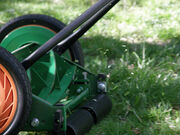(+ reformatting the related table and adding references about the history of lawns) |
(fixed typo in caption and moved picture) |
||
| (3 intermediate revisions by the same user not shown) | |||
| Line 7: | Line 7: | ||
For many people a specific image of a lawn as part of how a house ''should'' look has become so ingrained that they plant "traditional" lawns in places where they are not native and potentially harmful. For instance many people who moved to the southwestern part of the United States to get relief from allergies took with them and transplanted the very plants they were allergic to. In addition, these plants do not thrive easily in the desert climate, so they need constant watering and special care. There is a movement to go back to more regionally appropriate landscaping (see [[ground cover]]). |
For many people a specific image of a lawn as part of how a house ''should'' look has become so ingrained that they plant "traditional" lawns in places where they are not native and potentially harmful. For instance many people who moved to the southwestern part of the United States to get relief from allergies took with them and transplanted the very plants they were allergic to. In addition, these plants do not thrive easily in the desert climate, so they need constant watering and special care. There is a movement to go back to more regionally appropriate landscaping (see [[ground cover]]). |
||
| ⚫ | |||
| ⚫ | |||
| + | |||
| ⚫ | |||
| ⚫ | |||
==Related== |
==Related== |
||
| Line 29: | Line 30: | ||
|- |
|- |
||
|} |
|} |
||
| + | * [[how to get rid of weeds without harsh chemicals]] |
||
==References== |
==References== |
||
| Line 37: | Line 39: | ||
==External Links== |
==External Links== |
||
| − | *[http://www.howtostartyourlawncarebusiness.com How To Start a Lawn Care Business] |
+ | * [http://www.howtostartyourlawncarebusiness.com How To Start a Lawn Care Business] |
| + | * [[Bob Vila]]'s [http://www.bobvila.com/articles/2388-5-ways-to-a-greener-lawn/pages/1 5 Ways to a Greener Lawn]: Here are five tips for achieving a fertilizer-free, greener lawn this spring. By Kelsey Savage Hays |
||
[[Category:Exterior]] |
[[Category:Exterior]] |
||
[[Category:Gardening]] |
[[Category:Gardening]] |
||
Revision as of 02:19, 3 June 2012
The lawn is usually the mowed grass area around a building.

manual lawnmower and grass
A lawn can be a beautiful part of a landscape or a fun place to play.
For many people a specific image of a lawn as part of how a house should look has become so ingrained that they plant "traditional" lawns in places where they are not native and potentially harmful. For instance many people who moved to the southwestern part of the United States to get relief from allergies took with them and transplanted the very plants they were allergic to. In addition, these plants do not thrive easily in the desert climate, so they need constant watering and special care. There is a movement to go back to more regionally appropriate landscaping (see ground cover).
Historically lawns were a sign of wealth. Before lawnmowers a lawn had to be cut manually, usually by scythe or livestock, usually sheep. Hiring the cutters or buying the livestock took money, as well as being able to afford to have the land as an ornament instead of in productive use.

The "classic", stately, large house with green grass lawn.
Related
- how to get rid of weeds without harsh chemicals
References
History of Lawns
- History of the American Lawn (Reprinted with permission from the Guide for Real Florida Gardeners in The Limpkin: Newsletter of the Space Coast Audubon Society of Brevard County, Florida.)
- The History of Lawns in America (american-lawns.com)
- Wikipedia's article on History of the lawn
External Links
- How To Start a Lawn Care Business
- Bob Vila's 5 Ways to a Greener Lawn: Here are five tips for achieving a fertilizer-free, greener lawn this spring. By Kelsey Savage Hays